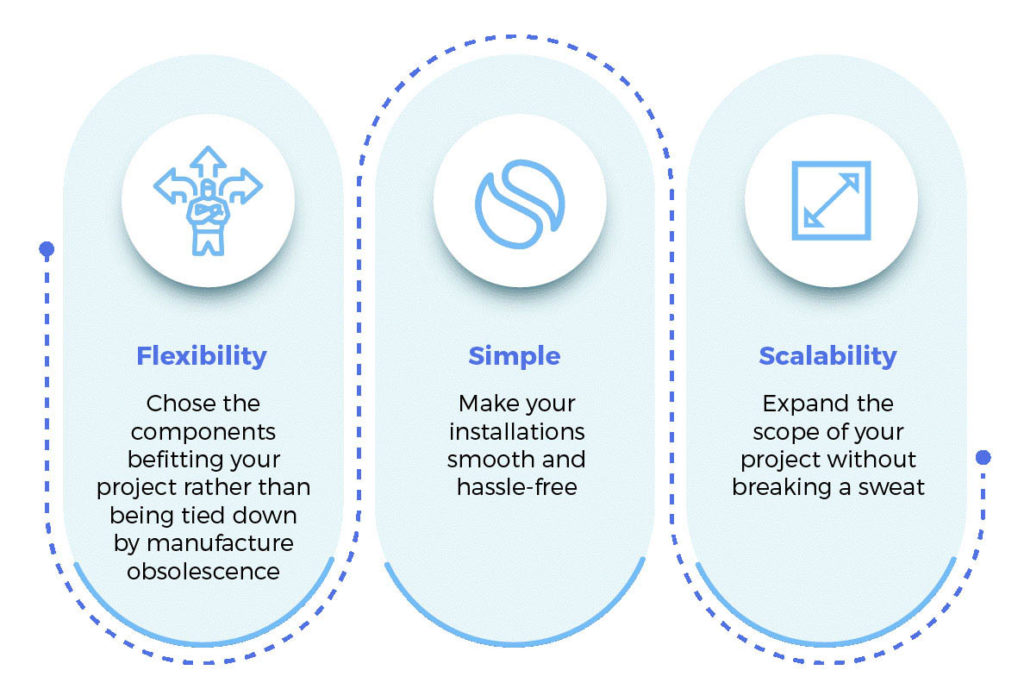Today, OEMs deal with a large variety of specifiers, architects, and building owners with varied lighting requirements. In this smart lighting era where light systems employ sensors and software technologies for automated lighting, it’s essential for them to rely on multiple vendors to include the best lighting components. That requires multiple lighting devices from different manufacturers to work together in harmony.
Interoperability helps devices from multiple manufacturers to operate together and communicate with each other to life-up lighting automations. This was also once the fanciful concept of an interoperable building, which is now a common buy.
Why Should OEMs Look for Interoperability?
In a simple system where an occupancy sensor needs to detect people-presence to glow luminaires, multiple devices need not function together. The system as a whole can work independently. However, in a centralized wireless lighting system, multiple devices like sensors, drivers, gateways, cloud, mobile applications, and control systems need to work in harmony. These components can be from different manufacturers with their outstanding products in each segment. It’s a common case for such combinations to produce the best results. That being the case, such systems require interoperable components so that OEMs can win smart lighting projects.
Six Advantages of Interoperable Components
When components from widely different manufacturers network together, interoperability offers a range of benefits to lighting OEMs. Here are some of the prime benefits that we feel qualifies the best;
- Best-of-breed components from top manufacturers
- Data sharing between all lighting and connected non-lighting systems
- Seamless modification and improvement of existing systems
- Devices functioning without reconfigurations
- Low cost on development and deployment
- Faster go-to-market
Do components from different maker create complexity in installations and integrations?
Definitely not. When OEMs bid on products from different manufacturers, the obvious complexity one would confront is the complexity in installation. Again, installing an occupancy sensor to turn ON/Off lights in response to people’s presence in a room is simple unlike in a centralized lighting control system.
An interoperable lighting system is expected to support device-to-device, system-to-system, and device-to-system interoperability. These combinations are vital as multi-vendor ecosystems are proven to have delivered far more benefits and performance efficiency in smart lighting projects.
Alongside, interoperability in wireless communication protocols is a most battled criterion. OEMs’ business is half done if they can achieve it in communication technology. Having said that, smart lighting being a cloud-to-device system, capabilities of all mentioned entities to operate together turns crucial.
Other Benefits

These are additional factors that make a lighting system perfect from an interoperability perspective.
However, the spaghetti loop of complexities exists with the multiple options available within interoperable lighting controls and systems. So, precisely evaluating for an optimal solution that caters to purpose driven interoperability is key to winning projects for OEMs.
The bottom line!
OEMs should adopt the best that suits their customer’s requirement. Usually, it’s a multi-vendor ecosystem that churns out the best results. And, that’s where the smart lighting world is headed to. The future is sure to be clear with systems that offer compatible and interoperable solutions that make tasks simple around retrofitting, building expansion, reconfiguration, product replacements, etc. We foresee a world that combines the best capabilities from different providers who holds industry-reputation in building technologies that they develop and pioneered in.
By hitting the submit button you authorize WiSilica to store and process your data in accordance with principles laid out in our privacy policy.






